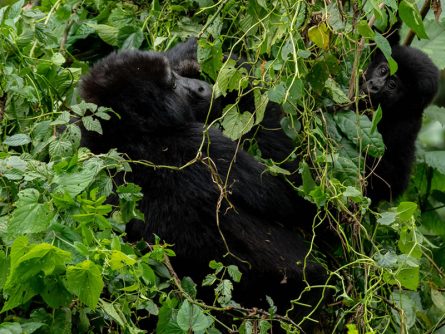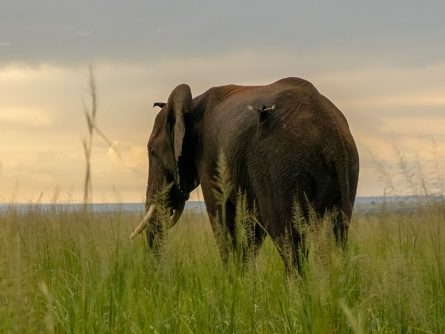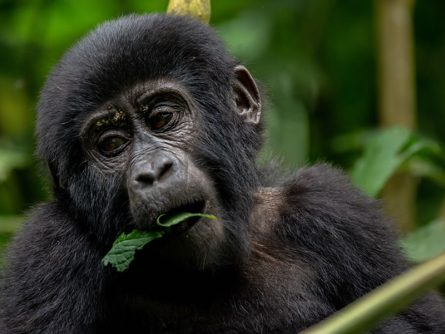Queen Elizabeth National Park is one of Uganda's most renowned wildlife destinations, offering a diverse range of experiences amid its stunning landscapes. Covering over 1,900 square kilometers, this park boasts a rich tapestry of habitats, including savannahs, wetlands, and forests. Whether you're a wildlife enthusiast, a nature lover, or simply seeking adventure, Queen Elizabeth National Park promises a captivating experience that will leave you with lasting memories.

KEY ATTRACTIONS AND ACTIVITIES
- Game Drives in Queen Elizabeth National Park: A Safari Adventure Like No Other
Queen Elizabeth National Park, renowned for its diverse landscapes and abundant wildlife, offers an exceptional game drive experience. Covering over 1,900 square kilometers, the park's varied ecosystems including savannahs, wetlands, and forests provide a perfect setting for observing a wide range of wildlife. Whether you're a seasoned safari-goer or a first-time visitor, a game drive in Queen Elizabeth National Park promises excitement and discovery at every turn.
What to Expect During a Game Drive in Queen Elizabeth National Park
Game drives in Queen Elizabeth National Park are typically conducted in open 4x4 vehicles, allowing for unobstructed views of the wildlife and landscape. These drives are usually led by experienced guides who are knowledgeable about the park’s wildlife, flora, and geography. The drives generally start early in the morning or late in the afternoon, as these are the times when wildlife is most active.
Early Morning Game Drives:
Early morning game drives usually start at around 6:00 AM. They offer the chance to see animals as they start their day. The cooler temperatures make wildlife more active, and you may catch sight of predators returning from their nocturnal hunts or herbivores grazing in the morning light.
Afternoon and Evening Game Drives:
These game drives typically start at round 3:00 PM or 4:00 PM. These drives offer a different perspective as animals prepare for the evening. The lower temperatures and setting sun create a picturesque backdrop for wildlife viewing, and you may witness dramatic interactions among animals as they gather around water sources.
Wildlife Encounters at Queen Elizabeth National Park
Queen Elizabeth National Park is home to a rich diversity of wildlife, and game drives provide ample opportunities to observe a variety of species in their natural habitats:
- The Big Four: While rhinos are not present in the park, the “Big Four” can be spotted:
- Lions: The park is known for its lion population, including the famous tree-climbing lions in the Ishasha sector.
- Leopards: Leopards are elusive and harder to spot, but with a keen eye and a bit of luck, you might see one resting in a tree or stalking prey.
- Elephants: Large herds of elephants are commonly seen roaming the savannahs and wetlands.
- Buffaloes: Massive herds of buffaloes can be spotted grazing on the open plains.
- Other Mammals:
- Giraffes: The park is home to both the Masai and Rothschild giraffe species.
- Antelopes: Look out for Uganda kob, topi, waterbuck, and impala as they graze in the park’s grasslands.
- Warthogs: These quirky, tusked creatures are frequently seen foraging on the plains.
- Primates and Other Species:
- Chimpanzees: Though not always visible during game drives, chimps can sometimes be spotted in the Kyambura Gorge area.
- Hippos: Large groups of hippos can often be seen wallowing in the water, particularly around the Kazinga Channel.
- Birdlife:
Diverse Avian Species: Queen Elizabeth National Park is a birding paradise with over 600 recorded species. Keep an eye out for the African fish eagle, martial eagle, and the colorful lilac-breasted roller.
Guides and Vehicles in the Queen Elizabeth National Park
Experienced Guides: Game drives are conducted by trained guides who provide valuable insights into animal behavior, tracking signs, and the park’s ecosystems. Their expertise enhances the safari experience, making it both educational and thrilling.
Open 4x4 Vehicles:The park uses specially designed open-top 4x4 vehicles that offer excellent visibility and comfort. These vehicles are equipped with safety features and communication tools to ensure a smooth and secure safari experience.
A game drive in Queen Elizabeth National Park offers an exhilarating and immersive safari experience. With its diverse wildlife, stunning landscapes, and expert guides, the park provides one of the best opportunities to experience the beauty and excitement of a classic African safari. Whether you're marveling at the majestic elephants, tracking elusive leopards, or enjoying the scenic vistas, a game drive in Queen Elizabeth National Park is sure to be a highlight of your Ugandan adventure.
- Boat Cruises on the Kazinga Channel in Queen Elizabeth National Park: A Serene Safari on the Water
Boat cruises on the Kazinga Channel in Queen Elizabeth National Park offer a unique and tranquil way to explore the park’s diverse ecosystems and observe its rich wildlife. Stretching approximately 32 kilometers, the channel connects Lake Edward and Lake George, creating a vital waterway that supports a variety of animals and birds. A boat cruise provides an excellent vantage point for wildlife viewing and enjoying the park’s stunning landscapes from a different perspective.
What to Expect During a Boat Cruise at Queen Elizabeth National Park
Boat cruises typically last 2 to 3 hours and are conducted on specially designed, open-sided boats that allow for unobstructed views of the wildlife and surroundings. These cruises are guided by knowledgeable rangers who offer insights into the park’s ecosystems, wildlife behavior, and conservation efforts.
Morning Cruises: Usually start around 8:00 AM, offering the chance to see animals that are active in the cooler morning hours.
Afternoon Cruises: Typically begin around 2:00 PM or 3:00 PM, providing a chance to enjoy the sunset and witness the changing light over the water.
Wildlife Encounters during the boat cruise in Queen Elizabeth National Park
- Hippos:
The Kazinga Channel is renowned for its large populations of hippos. These massive creatures can often be seen wallowing in the water or emerging to graze on the banks. Observe their interactions and learn about their social structures and behaviors from your guide.
- Elephants:
Elephants frequently visit the channel to drink and bathe. The cruise offers a chance to see these majestic animals up close as they interact with the water and each other.
- Birdlife:
The channel is a birdwatcher’s paradise, with over 60 bird species commonly seen. Look out for:
- African Fish Eagles: Often seen perched in trees, their distinctive call can be heard from a distance.
- Pied Kingfishers: These agile birds dive into the water to catch fish.
- Herons and Egrets: Frequently spotted along the shores and in the shallows.
- Crocodiles:
Nile crocodiles can sometimes be seen basking on the riverbanks or swimming in the channel.
- Other Wildlife:
Antelopes and Buffaloes: Depending on the season and water levels, you might also spot buffaloes, Uganda kob, and other wildlife along the channel’s banks.
A boat cruise on the Kazinga Channel in Queen Elizabeth National Park offers a unique and serene perspective on the park’s diverse wildlife and stunning landscapes. From observing large herds of hippos and elephants to spotting a wide variety of bird species, the cruise provides a memorable and relaxing way to experience the natural beauty of this remarkable park. Whether you’re looking to enjoy peaceful moments on the water or capture stunning photographs, a boat cruise in Queen Elizabeth National Park is a highlight of any safari adventure.
- Chimpanzee Tracking in Kyambura Gorge in Queen Elizabeth National Park: An Exciting Primate Adventure
Chimpanzee tracking in Queen Elizabeth National Park offers an exhilarating opportunity to observe one of our closest relatives in their natural habitat. The park’s Kyambura Gorge, also known as the “Valley of Apes,” is renowned for its chimpanzee population and lush, forested environment. This activity combines adventure with wildlife observation, providing an enriching experience for nature enthusiasts and primate lovers.
What to Expect During Chimpanzee Tracking at Queen Elizabeth National Park
Chimpanzee tracking typically involves a guided trek through the forested areas of Kyambura Gorge. The activity usually lasts between 2 to 4 hours, depending on the location of the chimpanzees and the terrain. Here’s what you can expect:
Preparation for Chimpanzee Tracking in Queen Elizabeth National Park
Briefing: Before the trek begins, you will receive a briefing from your guide. This includes information on safety, what to expect during the tracking, and guidelines for respectful wildlife observation.
Gear: Wear comfortable, long-sleeved clothing and sturdy hiking boots. The forest can be muddy and uneven, so appropriate footwear and clothing are essential. Bring a rain jacket, as the weather can be unpredictable.
Wildlife Encounters at Chimpanzee Tracking in Queen Elizabeth National Park
- Chimpanzees:
Once located, you’ll have the chance to observe chimpanzees in their natural environment. Chimpanzees are highly social animals, and you might see them engaging in various activities such as feeding, grooming, or playing.
Guides will share fascinating details about chimpanzee behavior, including their communication methods, social hierarchies, and daily routines.
- Other Primate Species:
- Red-tailed Monkeys: Often found in the same habitat as chimpanzees, these small primates are sometimes seen
- Forest Adventure:The Kyambura Gorge, also known as the "Valley of Apes," is a prime location for chimpanzee tracking. This lush, forested area provides an opportunity to observe these primates in their natural habitat. The experience is led by experienced guides who provide insights into chimpanzee behavior and ecology.
- Other Wildlife: Besides chimpanzees, the gorge is home to other primates like the red-tailed monkey and black-and-white colobus. The trek through the gorge’s dense forest is a rewarding adventure with opportunities to see diverse flora and fauna.
- Tree-Climbing Lions in the Ishasha Sector of Queen Elizabeth National Park: A Remarkable Safari Experience
The Ishasha Sector of Queen Elizabeth National Park is famous for its extraordinary population of tree-climbing lions, a unique and captivating phenomenon that draws wildlife enthusiasts from around the world. This rare behavior, observed in only a few places in Africa, provides a fascinating and memorable safari experience.
Tree-Climbing lion Behavior in Queen Elizabeth National Park
Tree-climbing lions are not commonly observed in most African wildlife reserves. In the Ishasha Sector, lions have adapted to climbing trees, which is believed to help them escape the heat, avoid biting insects, and gain a better vantage point for spotting prey.
The lions are often seen perched in large fig trees, which provide sturdy branches and ample shade. These trees are scattered across the savannah landscape, creating a picturesque setting for observing the lions.
Social Structure and Activity of tree climbing lions
Resting and Relaxing:The lions typically climb trees to rest and cool off during the heat of the day. They may be seen lounging on branches, napping, or engaging in grooming behavior.
Predatory Skills: Occasionally, the lions will use their elevated position to scan the surrounding area for potential prey. This behavior allows them to spot and stalk game more effectively.
Viewing Opportunities of the tree climbing lions in Queen Elizabeth National Park
Best Times for Sightings:
- Early Mornings and Late Afternoons:
The tree-climbing lions are most active and visible during the cooler parts of the day, such as early mornings and late afternoons. These are the best times to go on game drives to increase your chances of spotting them.
- Game Drives:
Experienced guides in the Ishasha Sector know the prime locations for finding the tree-climbing lions. They use their knowledge of lion behavior and the park’s geography to lead visitors to the best viewing spots.
Photographic Opportunities:
The sight of lions lounging on branches against the backdrop of the African savannah provides incredible photographic opportunities. The contrast of the lions against the sky and the surrounding landscape makes for striking images.
The tree-climbing lions of the Ishasha Sector in Queen Elizabeth National Park offer a truly exceptional safari experience. Their rare and fascinating behavior, combined with the stunning savannah landscape, creates a memorable and rewarding adventure for wildlife enthusiasts. Whether you’re a seasoned safari-goer or new to wildlife watching, witnessing these majestic lions in their arboreal habitats is a highlight of any visit to Queen Elizabeth National Park.
- Nature walks and hiking in Queen Elizabeth National Park
Queen Elizabeth National Park, renowned for its rich biodiversity and stunning landscapes, offers incredible opportunities for nature walks and hiking. These activities allow visitors to immerse themselves in the park's natural beauty, providing a closer look at its diverse wildlife, unique vegetation, and breathtaking scenery.
Nature Walks
Queen Elizabeth National Park offers guided nature walks that provide a more intimate experience of the park's ecosystems. These walks are typically led by knowledgeable guides who share insights into the flora and fauna, making it an educational journey as well as an adventure. One popular spot for nature walks is the Maramagambo Forest, a dense, tropical forest that is home to a variety of bird species, primates, and even the elusive forest elephants. As you walk through the forest, you'll hear the sounds of the jungle, spot vibrant butterflies, and possibly see the unique bat caves that house thousands of bats.
Another fascinating area for a nature walk is the Kyambura Gorge, often referred to as the "Valley of Apes." This steep gorge is a lush riverine forest where you can track chimpanzees and other primates, making it a thrilling experience for wildlife enthusiasts. The walk through the gorge is not only about chimpanzee tracking but also about experiencing the beauty of the verdant forest, spotting various bird species, and marveling at the scenic views.
Hiking
For those seeking more physical activity and a chance to explore the park's rugged terrain, hiking in Queen Elizabeth National Park is a must. The Mweya Peninsula offers a range of trails that vary in difficulty, from gentle slopes to more challenging climbs. These hikes reward adventurers with panoramic views of the Kazinga Channel and Lake Edward, often accompanied by sightings of warthogs, elephants, and even the occasional leopard.
Hiking in the Kasenyi Plains is another exciting option, especially for those interested in spotting large herds of Uganda kobs, buffaloes, and other savannah wildlife. The open plains provide a unique hiking experience, where you can enjoy the vastness of the African savannah, with the Rwenzori Mountains as a dramatic backdrop.
For a more off-the-beaten-path experience, the Kichwamba Escarpment offers a series of trails that take you along the edge of the Great Rift Valley. This area is less frequented by tourists, making it ideal for those looking for solitude and a deeper connection with nature. The trails here provide stunning views of the valley below, and on a clear day, you can see as far as the Congo.
Nature walks and hiking in Queen Elizabeth National Park offer visitors a unique way to experience the park's incredible biodiversity and stunning landscapes. Whether you're exploring the dense forests, tracking chimpanzees in Kyambura Gorge, or taking in the views from the Kichwamba Escarpment, these activities promise an unforgettable adventure in the heart of Uganda's wilderness.
- Cultural Encounters in Queen Elizabeth National Park.
Cultural encounters in Queen Elizabeth National Park offer visitors a unique opportunity to connect with the local communities and experience the rich cultural heritage of the people living around the park. These experiences go beyond wildlife and landscapes, providing a deeper understanding of the traditions, lifestyles, and history of the region’s inhabitants.
The Kikorongo Women’s Community
One of the most vibrant cultural experiences in Queen Elizabeth National Park is a visit to the Kikorongo Women’s Community. "Kikorongo" means "too much sunshine" in the local language, but the warmth of the women in this community far outshines the sun. Here, visitors can participate in traditional dance performances, where the rhythmic drumbeats and colorful costumes tell stories of the community's heritage.
The women of Kikorongo are also skilled in traditional crafts, such as weaving baskets, making beads, and crafting other beautiful items from natural materials. Visitors can take part in a workshop to learn these crafts firsthand, creating their own souvenirs to take home. The community also offers cooking demonstrations, where you can learn how to prepare local dishes using traditional methods, and enjoy a delicious meal afterward.
The Katwe Salt Lake Community
Another fascinating cultural encounter can be found at Katwe Salt Lake, where salt has been harvested using traditional methods for centuries. The Katwe community has a rich history of salt mining, which has been passed down through generations. A guided tour of the salt pans offers insight into the labor-intensive process of salt extraction, as well as the significance of this practice to the local economy and culture.
During the visit, you’ll have the chance to interact with the salt miners, who share their stories and the challenges they face in this harsh environment. The views of the crater lake and the surrounding landscape are breathtaking, and the experience is both educational and deeply humbling.
The Kasenyi Fishing Village
For a glimpse into the daily lives of local fishermen, a visit to the Kasenyi Fishing Village on the shores of Lake George is a must. This vibrant village is bustling with activity, especially in the early morning when fishermen return with their catch. Visitors can observe traditional fishing techniques, learn about the types of fish commonly found in the lake, and see how the fish are prepared and preserved for sale.
The village also offers opportunities to engage with the local community, where you can learn about their customs, beliefs, and the importance of fishing to their way of life. The Kasenyi Fishing Village experience provides a deep connection to the people who depend on the lake for their livelihood, offering a perspective on the challenges and rewards of living in harmony with nature.
The Bunyaruguru Community
The Bunyaruguru Community near the park’s boundary is another area rich in cultural experiences. This community is known for its strong cultural traditions and practices. Visitors can participate in a traditional homestay, where they live with a local family and experience daily life as the Bunyaruguru people do. This includes participating in farming activities, preparing meals, and engaging in cultural rituals.
A highlight of this experience is learning about traditional medicine, where elders share their knowledge of herbal remedies made from local plants. The Bunyaruguru people also have vibrant music and dance traditions, and visitors are often treated to performances that reflect their history and beliefs.
Tips for Cultural Encounters in Queen Elizabeth National Park
Respect Local Customs: Always be respectful of the local customs and traditions. Ask for permission before taking photographs, especially of people.
Learn a Few Words in the Local Language: Learning a few greetings or phrases in the local language, such as Luganda or Runyankore, can go a long way in building rapport with the community.
Support Local Communities: Consider purchasing handmade crafts or products directly from the communities. This not only provides you with a unique souvenir but also supports the local economy.
Cultural encounters in Queen Elizabeth National Park offer an enriching complement to the wildlife experiences, allowing visitors to connect with the people who call this remarkable area home. These interactions provide a deeper appreciation of the region's cultural diversity, making your visit to the park truly unforgettable.
ACCOMMODATION OPTIONS IN QUEEN ELIZABETH NATIONAL PARK
- Luxury Lodges:
Kyambura gorge Lodge
Kyambura Gorge Lodge is a luxury lodge located on the edge of Queen Elizabeth National Park, overlooking the stunning Kyambura Gorge. The lodge is known for its unique blend of modern comfort and traditional African style, featuring bandas (thatched cottages) that offer breathtaking views of the park and the gorge. Guests at the lodge can enjoy a range of activities, including chimpanzee tracking in the gorge, game drives in the park, and community visits. The lodge also boasts a swimming pool, a spa, and a restaurant serving gourmet meals, making it an ideal retreat for visitors seeking both adventure and relaxation.
Elephant plains lodge: It offers a luxury accommodation experience in a serene setting. Located near the southern edge of Queen Elizabeth National Park, the lodge features well-furnished tents and cottages with en-suite bathrooms and private balconies. Guests can enjoy views of the surrounding savannah and a range of amenities including a restaurant, bar, and lounge area. The lodge is known for its excellent hospitality and provides easy access to game drives and boat cruises on the Kazinga Channel.
- Mid-Range Lodges:
Mweya Safari Lodge: Overlooking the Kazinga Channel, this lodge offers luxurious accommodations and stunning views. It features comfortable rooms, an infinity pool, and fine dining options.
Ishasha Wilderness Camp: Located in the Ishasha sector, this upscale camp provides a secluded and immersive experience, with luxurious tents and exceptional service.
Twin Lakes Lodge: Located near the park’s southern region, the lodge offers comfortable rooms with en-suite bathrooms and private verandas. The lodge features a restaurant, bar, and lounge area, creating a relaxing environment for guests. Twin Lakes Lodge is well-positioned for exploring the park’s diverse wildlife, including game drives and boat cruises on the Kazinga Channel. It is known for its peaceful setting and good service.
- Budget lodges:
Budget lodges in Queen Elizabeth National Park offer affordable accommodation options for travelers looking to explore the park without breaking the bank. These lodges typically provide basic but comfortable amenities, including clean rooms, en-suite bathrooms, and simple dining options. Some popular budget lodges include Pumba Safari Cottages, Kazinga Channel View, and Simba Safari Camp. These lodges often have prime locations near the park's major attractions, such as game drive circuits and the Kazinga Channel, allowing guests easy access to wildlife viewing and other activities. While the facilities may be modest, the warm hospitality and proximity to nature make these budget lodges a great choice for cost-conscious visitors.
WHAT TO BRING FOR THE BEST EXPERIENCE IN QUEEN ELIZABETH NATIONAL PARK
When visiting Queen Elizabeth National Park, packing the right gear is essential for a comfortable and enjoyable experience across the variety of activities you might engage in.
- Pack lightweight, neutral-colored clothing, such as khaki or green, to blend in with the environment and avoid startling wildlife. Long-sleeved shirts and trousers are ideal for protection against insects and sun. Mornings and evenings can be chilly, so bring warm layers like a fleece jacket. A waterproof jacket is also necessary, especially during the rainy seasons.
- Sturdy hiking boots are a must for nature walks and hikes, offering support on rugged terrain. Comfortable walking shoes are perfect for less strenuous activities, and sandals can be useful around your lodge.
- Bring binoculars for birdwatching and spotting distant animals, and a camera with a good zoom lens to capture the park’s stunning wildlife and landscapes. A small daypack will help carry essentials like water, snacks, and sunscreen during your excursions. Don’t forget insect repellent, high-SPF sunscreen, and a reusable water bottle to stay hydrated.
- Carry a basic first aid kit with band-aids, pain relievers, and any personal medications. A portable charger will keep your devices powered throughout the day, and a headlamp or flashlight is handy for navigating the lodge grounds at night.
- Ensure you have your identification, any necessary permits, and cash in Ugandan Shillings for tips and local purchases. While some places accept credit cards, it’s safer to have cash on hand.
By bringing these items, you’ll be well-prepared to enjoy the diverse activities that Queen Elizabeth National Park offers, from wildlife safaris to cultural encounters.
Practical Information about Queen Elizabeth National Park
- Best Time to Visit:
The best time to visit Queen Elizabeth National Park is during the dry seasons from June to September and December to February. During these periods, the weather is more favorable for wildlife viewing and outdoor activities.
- Getting There:
The park is accessible by road from Kampala, a drive that takes approximately 6-7 hours. There are also domestic flights available from Entebbe to the nearby airstrip at Mweya.
- Permits and Fees:
Entry fees to the park and permits for activities like chimpanzee tracking should be arranged in advance. It’s advisable to book these through local tour operators or the Uganda Wildlife Authority.
Queen Elizabeth National Park offers an exceptional safari experience with its diverse wildlife, scenic landscapes, and rich cultural interactions. Whether you’re seeking thrilling game drives, serene boat cruises, or insightful cultural encounters, the park provides a comprehensive and unforgettable adventure. With its unique blend of natural beauty and cultural richness, Queen Elizabeth National Park is a must-visit destination for any traveler exploring Uganda.






